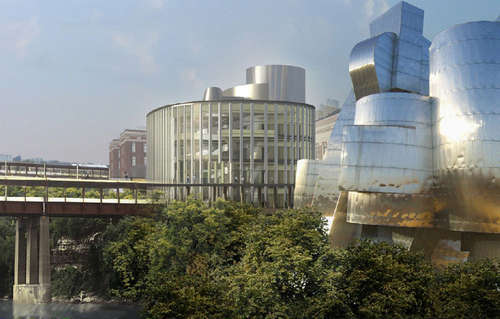New U of M Building to Pose Challenges to Bird Safety

The new Science Teaching + Student Services Building (center of photo) will rise over the next year on the East Bank of the Mississippi River.
Even buildings eligible for the highest green certifications can still bring challenges to the surrounding environment, as a project underway on the U of Ms east bank demonstrates.
Over the coming months, the Universitys new $72.5 million Science Teaching and Student Services Building will rise on the east bank of the Mississippi River, just across Washington Avenue from the Weisman Art Museum. The new building will provide cutting-edge spaces for teaching science, and will also add a new consolidated student services center.
The university has been clear it is designing the project to meet the highest standards of environmental certification. The project aims to receive LEED Gold certification the second-highest standard of certification in the Leadership in Energy and Environmental Design (LEED) system. But LEED does not address all challenges, and the buildings placement along the River raises some unique issues.
One of the issues unique to the river corridor is height and mass does the building visually integrate with the Mississippi River corridor? The proposed Science Teaching and Student Services Building is expected to be about the same height as the surrounding buildings that line the campus historic Northrup Mall. The first five floors of the building will rise 80 feet in all from East River Road. A penthouse, to be set back from the principal façades, will bring the buildings total height to 100 feet. Because of the areas dramatic topography, the building will be accessed from the third floor at the Washington Avenue level.
Though the building is similar in height to other nearby buildings, its prominent visual location on the Mississippi River Corridor is shared only by the Weisman Museum on the other side of Washington Avenue. The plan will create a much more substantial built presence on the river corridor than the former building, which had just one shorter story and a penthouse above Washington Avenue.
FMR tends to discourage the creation of new visual intrusions into the river corridor. On this site, the new riverside massing also amplifies another potential concern with the building. "We're concerned about the amount of glass used along what is a key migratory corridor for birds, said Steve Johnson, Chief of Natural and Cultural Resources for the MNRRA unit of the National Park Service.
The Mississippi River is a key migratory corridor for birds; the new building is to be clad in large amounts of glass (see renderings). In general, the mixture of birds and glass causes the potential for major problems. As an Audubon guide to creating bird-safe buildings notes, A major determinant of potential strikes is the sheer percentage of glass used on the building facade. In general, collisions will occur wherever glass and birds coexist.
Audubon also notes that several things can be done to diminish bird-glass collisions. Jan Morlock, the Us director of Community Relations, notes the buildings bird-friendliness has been the subject of notable discussion within the project team, and said the U is undertaking several strategies.
Morlock and the project development team said U plans to use low-reflectiveness glass, which will reduce the potential for birds to mistake reflections for the outdoors. Moreover, the glass will use a frit pattern to help the birds discern the glass from reality, another recommended treatment for glass. Finally, Morlock says, the U is working to keep all major landscaping such as trees far away from the windows, which is another recommended strategy to reduce the potential for collision.
While each of these strategies will improve the buildings friendliness to birds, none of them is part of the core standards employed by LEED certification, which remains the dominant measure of assessing a buildings environmental footprint. That absence troubles some bird advocates.
Joanna Eckles of Audubon Minnesota's Bird Safe program says that the design of bird-friendly buildings is just now gaining substantial recognition within the fields of architecture and planning. While LEED does not specifically call out bird safety as a required core element in its design criteria, several items within LEED can help projects earn points while improving bird safety.
Right now, Eckles says, it is just an innovation credit you can get for incorporating bird safety into your building, Eckles notes that there is movement afoot to try to incorporate bird safety as part of required checklist in LEED guidelines.
Including standards to reduce bird collisions in LEED standards may take some extra effort. It shouldnt be negotiable, says Karen Cotton, who leads the American Bird Conservancys bird collision campaign. If youre going to call a building sustainable, it just simply cant be this enormous collision risk for birds, she told Audubon magazine.
The University of Minnesota is unique among river corridor stakeholders in that they hold planning and zoning authority for their own campus. Though this project had to compete at the Capitol to get state funding, there are few built-in checks and little place for public input when it comes to campus planning and building design.